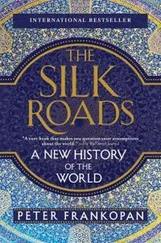1 ...6 7 8 10 11 12 ...28 Agriculture made possible not merely a phenomenal growth of human population, which is thought to have increased some 16-fold between 8000 and 4000 BC, but also gave rise to the familiar landscape of village communities which still characterized Europe as late as the middle of the 19th century and which even today prevails in many parts of the world. Nowhere are the continuities of history more visible. The enduring structures of human society, which transcend and outlive political change, carry us back to the end of the Ice Age, to the changes which began when the shrinking ice-cap left a new world to be explored and tamed.
FROM c . 5 MILLION YEARS AGO
HUMAN ORIGINS
Global cooling between five and six million years ago saw savannahs replace the tropical forests of sub-Saharan Africa. The appearance of this new environment was in turn matched by an evolutionary pulse that gave rise to new carnivores and omnivores. Among them were the hominines, the ancestors of modern man.
The earliest hominine fossils, discovered in the Afar region of Ethiopia, are the fragmentary 4.5-million-year-old remains of Ardipithecus ramidus . Better evidence is available of the later and more widespread Australopithecenes, or “southern apes”. Skeletal and fossilized footprints of Australopithecus afarensis , dated to between three and four million years ago, indicate a serviceable if not fully bipedal gait, hands still partly adapted for specialized tree climbing and a brain approximately one-third the size of ours. This species is the probable ancestor both of the robustly built Australopithecines boisei , aethiopicus and robustus , all with large teeth and herbivorous diets, and of our genus, Homo , meaning “man”. A major discovery thrown up by fieldwork since the 1950s has revealed that these closely related but nonetheless distinctive species not only lived at the same time but side by side in the same habitats. Finds of more species are expected.
From between two and three million years ago, there is evidence of important evolutionary trends in Homo : brains became much bigger, a process known as encephalization; and full bipedalism was attained—as the 1974 discovery of the fossil skeleton known as ‘Lucy’ shows. As larger brains need better diets to sustain them, the increase in brain size could only have occurred as a result of significant evolutionary pressures. The problem was compounded because hominines stayed the same size, with the result that their bigger brains could be achieved only by reducing the size of another organ, the stomach, a trade-off which in turn reduced the efficiency of the digestive tract, which in turn demanded a still better diet.
EARLY TECHNOLOGIES
The most convincing explanation of this development—the expensive tissue hypothesis—holds that a move towards an energy-rich diet, particularly animal proteins, was responsible. And indeed the earliest-known stone tools, found in Gona, Ethiopia, suggest that 2.5 million years ago meat was a central part of hominines’ diet, with the sharpened stones used to cut flesh and pound marrowrich bones from carcasses either scavenged or brought down and then defended against carnivores. Burnt bones found in southern Africa indicate that by 1.5 million years ago hominines had learned to “cook” their food, a development which again would have compensated for smaller stomachs by breaking down animal proteins before digestion took place.
OUT OF AFRICA
This pattern of development was the basis for the first colonization, by Homo erectus , 1.8 million years ago of areas outside sub-Saharan Africa. Then, around 500,000 years ago, Homo heidelbergensis migrated into north Africa and the Near East, reaching northern Europe about 400,000 years ago (however there is also good evidence in northern Europe for hominines 700,000 years ago). Homo erectus and heidelbergensis are sometimes considered to have shared a common ancestor, a type designated as Homo ergaster , and best known from the skeleton found at Nariokotome in Kenya’s Rift valley. By perhaps 1.5 million years ago, all three had brains of about 1000cc (61cu in) and an adaptable stone technology: the weight and careful shaping of the edges of their distinctive handaxes, whether pointed or oval, made them effective butchery tools.
Stone technology was not the only factor in the evolutionary pressures that led to larger brains. It was also to do with allowing hominines to remember, to manipulate, to support and to organize others in more complex ways. Perhaps paradoxically, as hominines developed these more sophisticated social structures, so they simultaneously became less reliant on one another and better adapted to living in smaller groups. This in turn allowed them to colonize harsher barrier habitats such as the Sahara at the margins of their homelands from where they could colonize new, more temperate areas beyond.
MODERN HUMANS
From about 500,000 years ago, this early burst of colonization came to a halt. Instead, though there were undoubtedly many dispersals of populations and much intermingling of genes, regional groups of separate populations living side by side such as the Neanderthals developed. But from 100,000 years ago, another major dispersal began when anatomically modern people— Homo sapiens sapiens —emigrated from sub-Saharan Africa. By 50,000 years ago, Australia had been reached, by boat; 33,000 years ago, the western Pacific islands were colonized; 15,000 years ago, the Americas were reached. Major expansion into the Arctic began about 4500 years ago as the continental ice sheets retreated. Finally, 2000 years ago, humans began to settle the deep Pacific islands from where they reached New Zealand around 1200 years ago, 1000 years before the island’s discovery by Captain Cook.
FROM c . 200,000 YEARS AGO
THE SPREAD OF MODERN HUMANS
DNA studies have revealed that the first anatomically modern humans— Homo sapiens —arose in Africa between 200,000 and 140,000 years ago. Though much has still to be discovered about their origins and dispersal, by almost 28,000 years ago Homo sapiens had become not only the sole human species but the first truly global one.
The earliest modern-looking human skulls yet found are about 130,000 years old and come from the Omo basin in Ethiopia and Klasies River Mouth in southern Africa, the latter one of the best-researched sites of early human habitation. Perhaps 100,000 years ago, these early populations began to disperse, migrating northwards out of Africa. These migrations were followed by a process known as “bottlenecking” in which population levels among the dispersed peoples remained small for thousands of years. It is possible that a contributory factor to bottlenecking was the eruption of Toba in northwest Sumatra 71,000 years ago, an environmental catastrophe on an extraordinary scale: parts of India were covered with ash up to 3m (10ft) deep, global temperatures were lowered for a millennium. At the same time, the restricted populations generated by bottlenecking had the side effect of encouraging rapid changes in genetic structures thereby increasing the pace of evolutionary change.
Archaeological and genetic evidence then point to a further rapid expansion of modern human populations about 50,000 years ago. The archaeological evidence in particular highlights growing sophistication and the mastery of a wide and increasing range of skills. In some regions, lighter, multi-component weapons have been found, including spears made from skilfully produced stone blades fixed to wooden shafts and handles. There is evidence, too, of textiles and baskets, and of more orderly layouts of camp-sites, including cold-weather dwellings and underground food stores. Trading networks also increased dramatically. Raw materials, particularly stone, which had previously been traded over distances of less than 80km (50 miles), were now traded over several hundreds of kilometres (there is good evidence for this in eastern Europe).
Читать дальше










